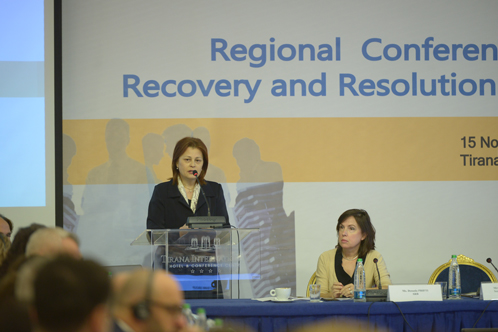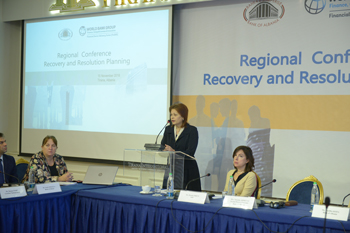BANK OF ALBANIA
PRESS RELEASE
Second Deputy Governor Ahmetaj: Opening remarks at the Regional Conference on Recovery and Resolution Planning, 15 November 2018
Publication date: 15.11.2018
Dear ladies and gentlemen,
Welcome to this regional conference organized by the Bank of Albania in cooperation with FinSAC, a valued partner in our path towards development.
The financial crisis of 2008 remains the starting point of a number of discussions, as many of our present efforts originate from this period. The 2008 crisis was a tough test for the capability of a state to manage national and cross-border crises. This test became even more relevant for its global capability, if we take into account that the crisis originated in advanced economies, but spilled over into emerging markets and developing economies.

In order to safeguard core financial services for their citizens and firms, governments were forced to use public funds, by injecting money and issuing guarantees for distressed financial institutions at unprecedented levels. From October 2008 to October 2011, the European Commission approved EUR 4.5 billion from public funds to support financial institutions. Naturally, this support helped to curb, at least in the short-term, a massive bankruptcy of banks and the collapse of the real economy. On the other hand, it burdened taxpayers with deteriorated public finances. This forced situation strengthened the need to reflect on the protection of the taxpayers and public finances in times of crisis, without sacrificing the prevalence of public interest. Such reflection served to promote discussion on the adequacy of financial markets’ regulation to withstand crises. Two important shortfalls in the regulatory framework were identified.


First, the banking legislation established clear rules for the orderly entry of new participants in the market but did not define the mandatory requirements for an orderly exit for the troubled market participants. Now in the post-crisis period, almost everyone agrees that, in the absence of a resolution regime, in order for a smooth and orderly exit of problematic banks, governments were forced to use public funds. Second, as a result of the high level of financial integration internal shocks in a given country were transmitted across borders to other countries, transforming them into a global issue.
The post-crisis analysis motivated the European Union to assess issues related to banks’ recovery and resolution, and consider strengthening the existing cross-border cooperation, to reflect better the actual integration of financial markets. Today, the banking union in Europe has introduced harmonized rules about resolution throughout the European Union, and a unified application for the euro area. More specifically, the legislation of the European Union has activated the European Bank Recovery and Resolution Directive (BRRD) for all member countries and has established the Single Resolution Mechanism (SRM) in the euro area, as well.


The BRRD creates such instruments for a preventive recovery and early intervention in a bank, designed to avoid the failure of a bank, as well as facilitate an orderly resolution when banks are failing, to protect the public interest. The new Law replaces the standard insolvency proceedings of a bank with the resolution undertaken by the relevant authority. Banks’ failures and financial crises may be common events. They are very costly, as well, which, in some cases, can be as high as 40-60% of the Gross Domestic Product. This includes losses in deposits, weakening of access to finance and loss of public confidence in the financial system, which, in turn, reduces its capacity to support economic growth and decrease poverty. Also, standard insolvency proceedings for failing banks proved inadequate in times of crisis because they did not address systemic risk nor ensured the continuity of critical functions; moreover, they did not protect depositors. These procedures require time, long negotiations as well as complex arrangements with creditors, which may damage and further diminish the asset value of the distressed bank, hence causing severe consequences for the real economy.

For this purpose, the new Recovery and Resolution Law provides the Supervisory and Resolution Authorities with the legal capacity and the necessary instruments for restructuring bank operations, in the event its possible failure jeopardizes financial stability or undermines other objectives of the regulator. The aim is clear: on the one hand, we have the public interest on financial stability, while, on the other hand, remain the shareholders of the bank, who have voluntarily undertaken the risk by investing in the bank. If the shareholders rely on the possibility of an implied state guarantee for banks, this constitutes a moral hazard on their part, therefore increasing their risk appetite. The implementation of the Resolution Law formally eliminates the basis for the expectation for any such guarantee.
Among the costs caused by the failure of a bank, contagion is probably the highest, since it turns the problem of a single bank into a problem for the entire banking sector. It may happen for two reasons: due to the spillover effect of a bank’s exposure towards another, as well as due to public panic, that causes eventual massive bank runs. This channel is particularly pronounced for developing economies, where contagion is faster due to their weak financial literacy, the historical lack of bank failures, and the presence of weaker institutions. In this context, the resolution regime serves as a tool for restoring market discipline and avoiding the risk of contagion. In essence, resolution is an integral part of banking supervision applied to the final stage of a bank’s life, should measures taken during the standard or intensive supervision stages fail to improve the situation of a distressed bank.
The drafting of the resolution regime was accompanied by the strengthening of the supervision regulatory requirements, which aim to increase the resilience of the bank and strengthen the financial market structure to avoid the moral hazard. In the wake of the crisis, experts have reached the conclusion that there is no bank model that would perform well or poorly in times of crisis. Different models of failing banks showed that the issue stemmed from undertaking high risk, financing with short-term instruments and insufficient protection offered by capital, even where minimum requirements were met. This conclusion has been reflected in higher supervisory requirements for quantity and quality of capital and liquidity, limits on the leverage ratio and maturity mismatch between assets and liabilities. The banking sector needs to comply with these requirements within a defined medium-term framework.
Regulatory measures are also accompanied by the consensus on the need for structural reforms in the financial system, namely, separation of risk-bearing financial speculation activities from deposit collection activities, and issues related with too big to fail banks, by discouraging their excessive growth. The biggest lesson of the financial crisis was that micro-prudential supervision of banks was not sufficient to safeguard financial stability because the system as a whole behaves differently from individual parts. In an effort to make themselves safer, financial institutions may undertake such behaviours that collectively damage financial stability. The banking activity takes place through its own cycles, known as financial cycles, which may deteriorate the business cycle of the real economy. Banks are exposed to collective macroeconomic shocks, which weaken them, at the same time, thus affecting financial stability. The understanding of this lesson dictated the need for macro-prudential supervision in addition to the micro-prudential one. Among the most effective instruments of macro-prudential supervision are the requirements for capital buffers to counter the creation of systemic imbalances, as well as capital buffers for systemic banks, which being large enough, may cause social costs beyond their individual dimension. Through this new capital composition, the macro-prudential instruments manage the systemic risk before it materializes, decreasing the probability of occurrence and, after its materialization, minimizing losses that are absorbed by the higher level of capital.
But still a lot of work remains to be done.
It has long been recognized that a deeper financial integration also brings a better functioning of the European Union. Yet, financial integration showed to be shallow and reversible and, after the financial crisis, fragmentation increased against centralization and integration. The measures undertaken to reduce liquidity within each country improved the national financial stability, but neglected the effect on other countries. The banking union addressed these inadequacies by concentrating the national financial policies at the central level and aiming to fulfil two objectives: to ensure banks’ soundness and promote a deeper integration of the banking sector.
The Single Supervisory Mechanism plays an important role in these objectives. A stronger and more uniform supervision enhances banks’ stability and provides them with a more coherent framework of policies on cross-border banking, producing benefits compared with the fragmented system of national supervision. As Mario Draghi says: “Let’s keep in mind that fragmentation starts with the decision by banks not to operate in regions where the risk-return of lending is judged to be insufficient to remunerate their invested capital”.
Supervisors’ advice for banks in the post-crisis period remain the same: banks should adapt the business model to be more effective and profitable, improve risk management and manage the cleaning of the balance sheet from legacy assets. Despite the progress made, these tasks are yet to be completed and now is the most appropriate time to finalize them. The regulatory framework is clearer and more complete (the implementation of Basel III is starting), supervision is clearer in terms of methodologies and policies, and the application of FinTech allows banks for new ways to do business efficiently. Lastly, and more importantly, the overall macroeconomic framework is stabilised and the positive economic growth is stable.
The framework presented above is a good guideline to address the remaining post-crisis challenges. Is the adoption of international standards on financial stability safeguarding necessary? The answer is yes, because the globalization and interconnection of the banking sector needs the standardization of prudential regulation. However, while adopting international standards, it is important to keep in mind two issues: First, these standards have to adapt to the development level of the country and calibrated according to domestic conditions. Second, international standards pose a minimum of requirements, leaving it at the discretion of individual countries to undertake more stringent requirements.
The model of global integration is the economic model that has been adopted by most of the transition countries, such as Albania. Under this guidance, the Albanian banking market has demonstrated clear willingness and objectives for a swift harmonization with the legal framework of the European Union’s banking system, as well as with its significant changes since 2008. Although there are no cases of bank failures in the history of the Albanian banking sector, we have identified in our banking legislation the same loopholes found in other European economies. The development of hypothetical scenarios for coping with a potential exposure of the Albanian economy to the Greek sovereign debt crisis evidenced that the Bank of Albania - as the supervisory authority of the banking sector - did not have all the necessary legal instruments to manage insolvency situations in systemically-important banks. This need for a new legal framework is addressed in both national and cross-border aspects, by the Bank Recovery and Resolution Directive. In fact, the initial efforts to prepare and present the first recovery plan to the Bank of Albania started in 2012. The relevant Regulation was approved by the Supervisory Council of the Bank of Albania in 2014. But, of course, these efforts were made within the supervisory legal authority and, as such, they were not sufficient. For this reason, during 2015, with the support of World Bank’s FinSAC project, the Bank of Albania started the difficult but necessary work of harmonizing the European Directive into a new Albanian law.
The Law ''On the recovery and resolution of banks in the Republic of Albania'’ entered into force in July 2017, vesting the Bank of Albania with a new attribute, i.e. the Resolution Authority. This attribute completes the financial security mechanism of the banking sector, with the Bank of Albania responsible for regulating and supervising the banking sector, drafting macro-prudential policies, performing the function of the lender of last resort as well as the implementation of banks’ resolution. Together with the deposit insurance scheme provided by the Deposit Insurance Agency since 2002, the financial safety net framework in Albania is complete. For the purposes of this Law, the Resolution Fund was created with contributions from the banking sector. This Fund aims to reach ALL 6.3 billion within 2027.
The implementation of the Albanian recovery and resolution Law consists in three important steps:
The first step is the drafting of recovery plans by each bank operating in Albania, with reliable and concrete scenarios, as well as defining the indicators that signal the deterioration of the financial situation of a bank before it becomes irreversible. When drafting recovery plans, the bank should create credible options to withstand stress scenarios, constructing mechanisms that are part of the daily management of the banking business and that do not remain just part of a hypothetical plan. Although drafting recovery plans is the task of individual banks, the Bank of Albania, in its capacity as the Supervisory Authority, plays an essential role in assessing the quality and reliability of these plans.
During 2018, banks have prepared recovery plans based on a new bylaw adopted by the Bank of Albania that sets out their detailed content. The opening panel of this Conference will present concretely our assessment of these plans. In brief, we may say that our challenges remain the same as those faced by other supervisory authorities, whether in European or regional countries. In sound financial situations, such recovery planning allows the Bank of Albania to deeply understand the structure and activity of the bank, thus supporting our supervisory process to identify areas for improvement, as well as bank’s self-diagnosis in these areas. In stressed financial situations, the recovery plan is the main document the bank has to correct its difficulties and, as such, it must be efficient, applicable and comprehensive.
The second step of the new crisis management framework is related with the early intervention in the bank. This step is activated if, after the implementation of the recovery plans, the bank’s actions fail to improve the situation. The Bank of Albania, in the capacity of the Supervisory Authority, undertakes several concrete early intervention measures in the bank, before the bank shows signs of insolvency. Currently, we are in the process of drafting bylaws for the early intervention implementation in accordance with the new legal requirements.
The third step is the resolution of banks, applied by the Bank of Albania in view of the new mandate. Similar to recovery plans, the resolution plans drafted by the Bank of Albania aim to identify the legal and structural obstacles and difficulties with financial resources that banks face, toward resolvability. In this regard, the resolution plans are one of the key instruments to facilitate the Bank of Albania’s resolution implementation.
This year in April, the Bank of Albania approved a bylaw that defines the content of resolution plans. Then banks were required to report a broad set of data for drafting these plans, based on the model of the European Banking Authority and we are currently in the process of drafting them. The drafting of the banks resolution plans is complicated, which includes complex and cross-border issues that must be implemented and coordinated within a short period of time. Hence, the resolution planning is an on-going process and a long-term mission to remove obstacles against the possibility for resolution action in banks. This planning does not mean drafting an annual plan that is stored somewhere in some shelf and it is dusted off only when its implementation is necessary; instead, it is the beginning of a long process of restructuring all aspects of the banking business that may hinder this process. Our point of view is that this process belongs equally to the Bank of Albania as the Resolution Authority and to the banks, which must include its results into their daily business.
During the first cycle of this work in 2018, we have highlighted a number of issues that require particular attention in planning, as well as in their following up by the banks:
- The Bank of Albania must have access to qualitative data produced by banks, in order to select the appropriate resolution strategy.
- The exact identification of the bank’s operational system interconnected with the critical functions is important.
- The proper understanding of contractual agreements and their respective treatment is imperative, and, in particular
- The provision of resolution funding sources constitutes a challenge.
Complying with the Minimum Requirement for Own funds and Eligible Liabilities (MREL), which underpins the application of the new essential resolution instrument, the bail-in instrument, remain the key challenge for the medium-term period. Complying with MREL is a challenge for countries like Albania, due to the capacity of the domestic market to absorb (acquire and maintain) the subordinate debt that may serve to fulfil the Minimum Requirement as well as due to the capacity of the banks to restructure funding resources, which currently consist largely of deposits. Consequently, to fulfil this obligation an interim period should be designed, without prejudice, in any case, to the main objective of resolution implementation.
Finally, resolution is quite a challenging process for emerging and advanced economies. The banking sector in the Balkans is dominated by foreign-owned banks. In Albania, subsidiaries of foreign banks account for around 78% of banking sector assets, while those from European countries account for 48%. The Bank of Albania is the Resolution Authority for seven subsidiaries of EU based banking groups, of which four are classified as systemically important under the mandate of the Single Resolution Board (SRB). Due to this, the signing of cooperation agreements between the resolution authorities of the banking group and the local authorities where the subsidiary operates is very important for coordinating actions, exchanging data for planning and implementing the resolution, and coordinating crisis management. I have the pleasure to share with you the news that the Bank of Albania has signed an important cooperation agreement with the Single Resolution Board, i.e., the Resolution Authority of the Banking Union, on 3 October 2018.
Dear ladies and gentlemen,
This Conference is the culmination of our work over the past 18 months for developing a complete framework for bank recovery and resolution. For this reason, the presence of colleagues from supervisory and resolution authorities from various entities assumes special importance. We have representatives from the European Union at the central level, from individual countries of the European Union and representatives from countries of the region, national and foreign bankers as well as the representatives of the media. This presence means sharing experiences and opportunity to evaluate what has been done.
I am confident that today, among other things, we will also build new bridges to coordinate our efforts for a sustainable financial system, within and beyond geographical boundaries.

 Twitter
Twitter
 Youtube
Youtube
 Facebook
Facebook
 Flickr
Flickr
 RSS
RSS
 Subscribe
Subscribe
 Feedback
Feedback